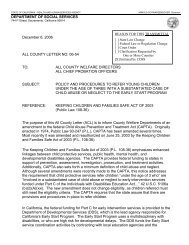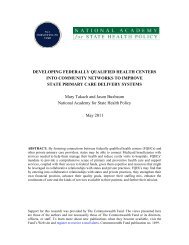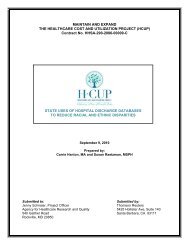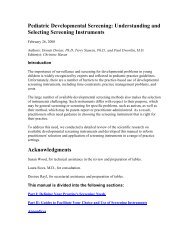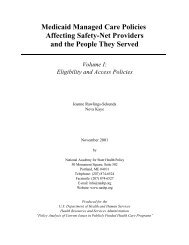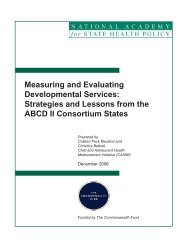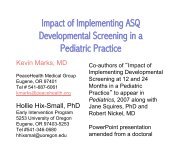Improving Care Coordination, Case Management, and Linkages to
Improving Care Coordination, Case Management, and Linkages to
Improving Care Coordination, Case Management, and Linkages to
Create successful ePaper yourself
Turn your PDF publications into a flip-book with our unique Google optimized e-Paper software.
15<br />
managed care. Children enrolled in Medicaid managed care are entitled <strong>to</strong> the full EPSDT benefit. In some<br />
states, managed care plans are responsible for the provision of all EPSDT services, <strong>and</strong> states structure<br />
contractual arrangements with plans. In other states, the Medicaid agency may be responsible for coverage<br />
of supplemental services beyond those listed in the managed care agreement (e.g., case management,<br />
dental services, specialty care). Certain children, such as those who receive SSI or those in foster care,<br />
may be exempt from managed care enrollment requirements <strong>and</strong> receive all of their coverage on a fee-forservice<br />
basis.<br />
To a great extent state Medicaid agencies also define the structures of how care is provided (e.g., contracting<br />
with managed care organizations or financing primary care case management – PCCM – arrangements).<br />
Traditionally, Medicaid has financed two types of case management: 1) as an administrative<br />
activity with federal contributions set at a fixed 50 percent; <strong>and</strong> 2) medical assistance (also known as<br />
targeted) case management with federal contributions at the state’s medical assistance matching rate. In<br />
general, Medicaid’s medical assistance case management is used <strong>to</strong> provide case management <strong>to</strong> targeted<br />
groups (e.g., pregnant women, CSHCN, a rural county or urban area). Administrative case management is<br />
typically used for activities such as informing recipients or utilization review. Both are widely used by states<br />
in efforts <strong>to</strong> provide CC/CM <strong>to</strong> children. As described above, in some states the term “care coordination”<br />
is used interchangeably <strong>to</strong> describe similar activities; however, most state Medicaid agencies finance only<br />
services labeled case management.<br />
The Deficit Reduction Act of 2005 (DRA) included a number of amendments <strong>to</strong> Medicaid, including<br />
changes in the definition of medical assistance case management (found in SSA §1915(g)). 32 Because the<br />
DRA amended §1915(g) of Medicaid law, the new definition does not apply <strong>to</strong> Medicaid administration<br />
obligations or administrative case management. The proposed rule on the case management provisions of<br />
the DRA issued by the Centers for Medicare <strong>and</strong> Medicaid Services (CMS) also refers <strong>to</strong> medical assistance<br />
case management. 33 So, for example, case management related <strong>to</strong> utilization review for care plans or<br />
other mechanisms related <strong>to</strong> efficient administration of benefits remain in effect.<br />
Federal law for EPSDT makes it clear that program administration includes activities that fall within the<br />
concept of case management, such as “providing or arranging for the provision of such screening services”<br />
<strong>and</strong> “arranging for corrective treatment.” Depending on the types of barriers a family might face in securing<br />
services, various administrative case management services might be needed <strong>to</strong> assure access <strong>to</strong> care.<br />
EPSDT regulations reiterate <strong>and</strong> exp<strong>and</strong> on the statute, including specific administrative obligations that<br />
families who want care actually can find <strong>and</strong> get it. For example, states’ obligations <strong>to</strong> inform families about<br />
benefits or provide assistance with transportation <strong>and</strong> scheduling well-child appointments remain in effect.<br />
Moreover, court decisions have served as a reminder <strong>to</strong> states that there is “a duty under 42 U.S.C. §<br />
1396a(a)(43) <strong>to</strong> inform Medicaid recipients about the EPSDT services that are available <strong>to</strong> them <strong>and</strong> that<br />
it [the state] must arrange for the corrective treatment prescribed by physicians,” 34<br />
stAt e ch i l d r e n’s he A lt h in s u r A n c e pro g r A m (chip)<br />
CHIP is a federal-state program <strong>to</strong> enable states <strong>to</strong> exp<strong>and</strong> health coverage <strong>to</strong> uninsured, low-income children<br />
(<strong>and</strong> their parents). While not an entitlement of coverage like Medicaid, CHIP funds help states provide<br />
health insurance coverage <strong>to</strong> uninsured children up <strong>to</strong> 200 percent of Federal Poverty Level (<strong>and</strong> with federal<br />
approval above that level). States’ CHIP plans either exp<strong>and</strong> eligibility for children under Medicaid or create<br />
a separate children’s health insurance program managed by the state (<strong>and</strong> typically operated by private<br />
insurance companies).<br />
<strong>Improving</strong> <strong>Care</strong> <strong>Coordination</strong>, <strong>Case</strong> <strong>Management</strong>, <strong>and</strong> <strong>Linkages</strong> <strong>to</strong> Service for Young Children: Opportunities for States<br />
National Academy for State Health Policy



